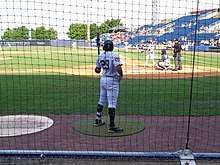On-deck
In baseball, on deck refers to being next in line to bat. In a professional game, the batter who is on deck traditionally waits in a location in the foul territory called the on deck circle.

Being on deck only guarantees the batter will get a chance to bat in the inning if there are fewer than two outs, and the number of outs plus the number of baserunners (including the one at bat) adds up to fewer than three because a double or triple play could occur. Additionally, the manager reserves the right to pull the on-deck hitter for a substitute at his discretion.
The player next in line to bat behind the on deck batter is referred to as being in-the-hole.
Significance in save situations
A relief pitcher who comes in to pitch when his team is ahead can earn a save if the tying run is either on base, at bat, or on deck, and he then finishes the game without giving up the lead.[1]
On-deck circles
There are two on-deck circles in the field, one for each team, either circle can be used by either team, positioned in foul ground between home plate and the respective teams' benches. The on-deck circle is where the next scheduled batter, or "on-deck" batter, warms up while waiting for the current batter to finish his turn. The on-deck circle is either an area composed of bare dirt; a plain circle painted onto artificial turf; or often, especially at the professional level, made from artificial material, with a team or league logo painted onto it.
According to Major League Baseball rules, there are two on-deck circles (one near each team's dugout). Each circle is 5 feet in diameter, and the centers of the circles are 74 feet apart. A straight line drawn between the centers of the two on-deck circles should pass 10 feet behind home plate.

References
External links
